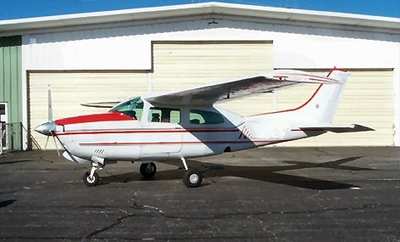Two Fatally Injured When Cessna 210 Went Down In The Gulf Of Mexico
The NTSB has released a preliminary report from an accident involving a Cessna 210 which went down in the Gulf of Mexico shortly after takeoff from Marathon International Airport (KMTH) in the Florida Keys. The commercial pilot and passenger were fatally injured.

The personal flight was conducted under night visual meteorological conditions. An instrument flight rules flight plan was filed for the planned flight which departed MTH at 0629 to Savannah/Hilton Head International Airport (KSAV), Savannah, GA.
According to the report, the airplane was completely fueled when it arrived at KMTH on September 6, 2019. Review of ADS-B track data for the accident flight revealed that it departed on runway 25 and initially made a right climbing turn. The airplane reached an indicated altitude of 425 ft mean sea level about 90° through the turn, before descending in the turn and impacting the water. The airplane's groundspeed continued to increase, from about 70 knots at liftoff, to 100 knots at the height of the right climbing turn, to 146 knots at the end of the data. Review of airport surveillance video depicted the airplane's takeoff, initial climb, and turn toward an area of dark open water underneath a scattered cloud layer.
The wreckage was examined following its recovery to a storage facility. Both wings and the engine had separated during impact. The right wing exhibited more impact damage than the left wing. The right flap separated and its actuator was found in the retracted position. The left flap remained attached, exhibited impact damage, and was partially extended. The right aileron separated and only small pieces of it were recovered. The left aileron remained partially attached to a separated section of left wing. Both wingtip sections separated and were not recovered. The right horizontal stabilizer and right elevator exhibited leading edge damage and separation at the outboard section. The left horizontal stabilizer and left elevator were less damaged. There was no damage to the vertical stabilizer or rudder.
The landing gear was retracted. Control continuity was confirmed from all control surfaces (except for the right aileron) through cable breaks at the fuselage, to the cockpit controls. The cable breaks exhibited broomstraw features consistent with overload separation. Pieces of the right aileron were recovered and the right aileron bellcrank was not recovered; however, the right aileron cable was recovered and exhibited broomstraw features consistent separation. Measurement of the elevator trim jackscrew corresponded to an approximate neutral elevator trim position.
The cockpit was crushed and separated from the fuselage. The pilot and copilot seats were not recovered. The fuel selector valve was positioned to the left fuel tank. The attitude indicator gyro was disassembled for examination. Its rotor and housing were corroded. The directional gyro was also disassembled for examination. It's rotor and housing were corroded; however, one rotational score was observed on the housing. The vacuum pump was disassembled, its rotor, vanes, and shear shaft remained intact. Fuel was recovered from the fuel selector valve and the fuel manifold. It was consistent in color and odor to 100 low lead aviation gasoline.
The propeller separated from the crankshaft flange. One propeller blade was twisted while the other blade was bent aft and exhibited a leading edge gouge. The spark plugs were removed and their electrodes were intact and gray in color. The crankshaft was rotated by hand via the propeller flange. Camshaft, crankshaft, and valve train continuity were confirmed to the rear accessory section of the engine. Thumb compression was attained on all cylinders. Borescope examination of the cylinders did not reveal any anomalies. Both magnetos produced spark at all posts when rotated via an electric drill. The engine driven fuel pump remained attached and could be rotated by hand. It was then disassembled and no anomalies were noted. The oil filter was opened and its element was absent of contamination. The fuel metering unit remained partially attached to the engine and did not exhibit any anomalies.
The pilot held a commercial pilot certificate with ratings for airplane single-engine land and instrument airplane. His most recent Federal Aviation Administration third-class medical certificate was issued on February 10, 2018. At that time, he reported a total flight experience of 1,500 hours.
The four-seat, high-wing, retractable tricycle-gear airplane was manufactured in 1961. It was powered by a Continental IO-470, 260-horespower engine, equipped with a two-blade, constant-speed McCauley propeller. Review of maintenance records revealed that the airplane's most recent annual inspection was completed on April 5, 2019. At that time, the airframe had accrued a total time of about 3,914 hours and the engine had been operated about 895 hours since major overhaul. According to the tachometer, the airplane flew an additional 45 hours from the time of the annual inspection, until the accident.
(Source: NTSB. Image from file. Not accident airplane)
 ANN's Daily Aero-Term (04.24.24): Runway Lead-in Light System
ANN's Daily Aero-Term (04.24.24): Runway Lead-in Light System ANN's Daily Aero-Linx (04.24.24)
ANN's Daily Aero-Linx (04.24.24) Aero-FAQ: Dave Juwel's Aviation Marketing Stories -- ITBOA BNITBOB
Aero-FAQ: Dave Juwel's Aviation Marketing Stories -- ITBOA BNITBOB Classic Aero-TV: Best Seat in The House -- 'Inside' The AeroShell Aerobatic Team
Classic Aero-TV: Best Seat in The House -- 'Inside' The AeroShell Aerobatic Team Airborne Affordable Flyers 04.18.24: CarbonCub UL, Fisher, Affordable Flyer Expo
Airborne Affordable Flyers 04.18.24: CarbonCub UL, Fisher, Affordable Flyer Expo



